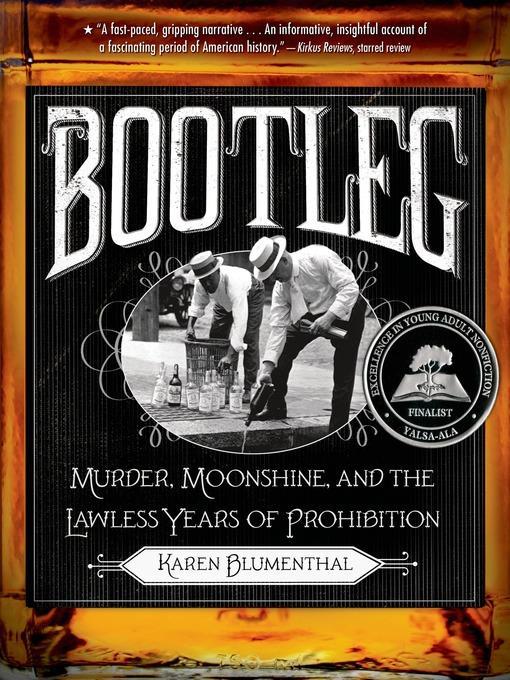
Bootleg
Murder, Moonshine, and the Lawless Years of Prohibition
فرمت کتاب
ebook
تاریخ انتشار
2011
Lexile Score
1250
Reading Level
8-11
ATOS
9.1
Interest Level
6-12(MG+)
نویسنده
Karen Blumenthalناشر
Roaring Brook Pressشابک
9781466801585
کتاب های مرتبط
- اطلاعات
- نقد و بررسی
- دیدگاه کاربران
نقد و بررسی

Starred review from April 15, 2011
When Congress passed the 18th Amendment, prohibiting the manufacture and sale of alcohol, supporters were convinced it would create a stronger, more moral nation. Instead, it ushered in an era of corruption and lawlessness, here brought to life with a fast-paced, gripping narrative and period photographs.
The story opens dramatically in 1929 with the St. Valentine's Day Massacre, the murder of seven Chicago men that epitomized the gangland violence that became a routine by-product of bootlegging. Blumenthal then chronicles the rise of the temperance movement in the late 1800s, the passage of and life under Prohibition and its repeal in 1933. The story is populated with colorful and notorious characters, such as the hatchet-wielding Carry Nation, gangster Al Capone and Morris Sheppard, the golden-tongued senator and champion of Prohibition. Drawing from period newspaper accounts, personal anecdotes and other primary sources, the author puts a human face on history, chronicling how parents brewed booze in their bathtubs and children smuggled the hooch. Blumenthal acknowledges that Prohibition was successful in some notable ways: Arrests for public intoxication declined as did alcohol-related diseases such as cirrhosis of the liver. Whatever positive outcomes there were, however, were eclipsed by the widespread corruption and violence of bootlegging.
An informative, insightful account of a fascinating period of American history. (glossary, bibliography, source notes) (Nonfiction. 12 & up)
(COPYRIGHT (2011) KIRKUS REVIEWS/NIELSEN BUSINESS MEDIA, INC. ALL RIGHTS RESERVED.)

Starred review from July 1, 2011
Gr 7-10-Gangsters, guns, and political battles-this book has them all-and presents them in compelling prose. Blumenthal opens with the infamous St. Valentine's Day Massacre, then traces the history of the temperance movement from the Puritans through the signing of the 21st Amendment. Important individuals are given the spotlight, some well-known like Al Capone and Carrie Nation, others more obscure but equally essential, such as Senator Morris Sheppard, the Father of National Prohibition. The author also adds a fascinating epilogue that examines the effects of the era, both positive and negative, including advances in technology and progress in legislative theory. Black-and-white period photographs and reproductions of propaganda material add immediacy to the text. The breadth of the well-researched material makes Bootleg a substantial resource for reports; a deep bibliography and copious source notes provide ample opportunities for further study. However, this book is also a lively read and an excellent choice for displays and booktalks. The subtitle alone will pique readers' curiosity.-Rebecca Dash Donsky, New York Public Library
Copyright 2011 School Library Journal, LLC Used with permission.

Starred review from April 15, 2011
Grades 8-12 *Starred Review* Blumenthal, author of the Sibert Honor Book Six Days in October: The Stock Market Crash of 1929 (2003), here offers a highly readable, well-shaped look at the Eighteenth Amendment, which she calls the most radical and ambitious social experiment ever tried. She provides concise, clearly written insights into the seeds of temperance movements in the late eighteenth century, which gained steam over the next century and finally reached a tipping point in the early twentieth century as an organized, powerful political movement. Of course, the grand social revolution that was supposed to forever end drunkenness, reduce crime, and make life better for Americas families did almost precisely the opposite, and the section on Al Capone will satisfy readers hungry for the gangster-warfare side of Prohibition. A closing chapter makes an argument that despite the mostly disastrous results, there were bright points to Prohibition (like the sharp plunge in alcohol-related diseases) and looks at modern-day reverberations like MADD and school drug- and alcohol-awareness programs. Plenty of archival images lend to the books pleasant design, and an ample bibliography and source notes close out this top-notch resource, which will also help spark discussion on the current War on Drugs.(Reprinted with permission of Booklist, copyright 2011, American Library Association.)

























دیدگاه کاربران